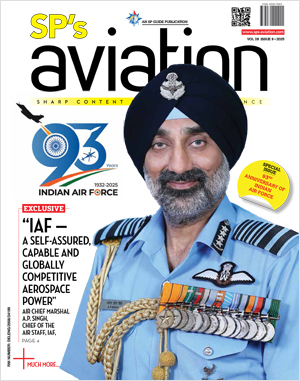INDIAN ARMED FORCES CHIEFS ON OUR RELENTLESS AND FOCUSED PUBLISHING EFFORTS

The insightful articles, inspiring narrations and analytical perspectives presented by the Editorial Team, establish an alluring connect with the reader. My compliments and best wishes to SP Guide Publications.

"Over the past 60 years, the growth of SP Guide Publications has mirrored the rising stature of Indian Navy. Its well-researched and informative magazines on Defence and Aerospace sector have served to shape an educated opinion of our military personnel, policy makers and the public alike. I wish SP's Publication team continued success, fair winds and following seas in all future endeavour!"

Since, its inception in 1964, SP Guide Publications has consistently demonstrated commitment to high-quality journalism in the aerospace and defence sectors, earning a well-deserved reputation as Asia's largest media house in this domain. I wish SP Guide Publications continued success in its pursuit of excellence.
- A leap in Indian aviation: Prime Minister Modi inaugurates Safran's Global MRO Hub in Hyderabad, Calls It a Milestone
- All about HAMMER Smart Precision Guided Weapon in India — “BEL-Safran Collaboration”
- India, Germany deepen defence ties as High Defence Committee charts ambitious plan
- True strategic autonomy will come only when our code is as indigenous as our hardware: Rajnath Singh
- EXCLUSIVE: Manish Kumar Jha speaks with Air Marshal Ashutosh Dixit, Chief of Integrated Defence Staff (CISC) at Headquarters, Integrated Defence Staff (IDS)
- Experts Speak: G20 Summit: A Sign of Global Fracture
Cirrus SR22: Choose CAPS for Safety!
Cirrus Aircraft and COPA set out to create a culture in which pilots who operated the CAPS system were celebrated – not criticised or even questioned – for their decision. This resulted in a steep drop in accident rates.

Cirrus Aircraft is well known in general aviation circles for its sleek designs and advanced avionics. But most of all, it is renowned for the innovative Cirrus Airframe Parachute System (CAPS), that has redefined the safety of small aircraft. According to the Cirrus Owners & Pilots Association (COPA), as of December 31, 2024, there have been 132 ‘saves’ – or successful operations of the CAPS system – with 269 survivors.
But first a word about Cirrus Aircraft’s flagship product. The Cirrus SR22 airframe is made almost entirely of composite materials, with fixed landing gear. It has a powerful Continental IO-550-N piston engine, rated at 310 total horsepower. Soon after the Cirrus SR22 entered service, it became the world’s bestselling general aviation aircraft, setting a new standard of luxury, performance and advanced technology. It has an intuitive glass cockpit, equipped with the Cirrus Perspective+ by Garmin – a state-of-the-art avionics system that provides pilots with comprehensive flight data, navigation and communications. The spacious, well-appointed cabin includes seating for the pilot and four passengers. In July 2024, the Cirrus SR series crossed the 10,000 deliveries milestone.
The CAPS story dates back to 1982, when Ballistic Recovery Systems (BRS) began producing parachutes designed for ultralight aircraft. It took another ten years for BRS to develop a system capable of saving a Cessna type aircraft, and the device was marketed as an optional retrofit on the Cessna 150/152. Meanwhile, Cirrus founder brothers Alan and Dale Klapmeier conceived of such a system after Alan miraculously survived a mid-air collision in 1985 where the pilot in the other plane spiralled into the ground and was killed. In 1998, BRS collaborated with Cirrus to develop the first recovery parachute device to be used on a type certified aircraft: the Cirrus SR20. The system, christened CAPS, was certified by the Federal Aviation Administration in October 1998. It was quickly followed, in 2001, by a system for the Cirrus SR22, with CAPS then becoming standard equipment on all 10,000+ Cirrus SR aircraft. CAPS still is the only aircraft ballistic parachute used as standard equipment by an aviation company. Cirrus followed suit by equipping its Vision SF50, the world’s first single-engine personal jet, with CAPS. The Vision Jet also has a Safe Return autoland system, which can be activated by passengers in an emergency, and safely land the aircraft automatically.
The 2,400 square foot CAPS parachute is stored in the aircraft’s empennage. The automatic system is activated by pulling a red T-handle in the cockpit. A solid-fuel rocket then fires, extracting the chute far from the aircraft. Once the chute safely deploys in a controlled manner, it supports the aircraft’s weight, ensuring a gentle descent with wings level, and ultimately lowering the plane safely on the ground or water. Unlike some other parachute recovery systems, deploying the parachute does not cause the aircraft to be written off. Depending on the degree of damage sustained on touchdown, Cirrus may repair the aircraft and put it back into service, as it has in many instances.
CAPS is most applicable to inexperienced pilots on solo flights in small aircraft whose engine suddenly quits. The “worst-case scenario” is when restarting attempts fail, and there are no airfields nearby. And that is when CAPS really proves its worth. Rather surprisingly, considering what a lifesaver the system can be, it initially received mixed reviews. Some veteran pilots felt it was a marketing gimmick that gave pilots a false sense of security and promoted risky behaviour. Indeed their opinion seemed to be borne out by a series of fatal accidents involving Cirrus SR22 planes. However, after carefully analysing accident case histories, Cirrus Aircraft and COPA set out to create a culture in which pilots who operated the CAPS system were celebrated – not criticised or even questioned – for their decision. This resulted in a steep drop in accident rates.
There have been several dramatic CAPS incidents involving Cirrus SR22 aircraft. In March 2023, shortly after takeoff from Pampulha Airport in Brazil, a Cirrus SR22 suffered engine failure. Realising there was insufficient glide range to return to the airport, the pilot deployed CAPS. His action resulted in the aircraft gently gliding, before safely touching down, and saved the lives of six people, including a threeyear-old and a new-born. A year later, shortly after departure from Shelter Cove Airport, California, a Cirrus SR22 engine quit and the pilot activated CAPS. The plane landed among trees, and was suspended for a brief period, before tumbling to the ground inverted. The three occupants – two adults and a child – emerged with only minor injuries. These two incidents illustrate how ingenious and effective CAPS is as a safety feature. Indeed, it is not just for aviators. It gives passengers a viable option to save themselves, should the pilot ever be incapacitated and unable to land their plane.





